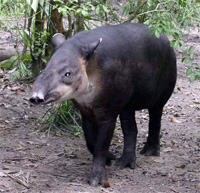Need a clue? It is also related to the horse and rhinoceros. Give up? It’s a tapir.
 Tapirs are rather strange, primitive creatures. They are big animals—measuring about six to eight feet between their short little trunk and their stubby little tail, and weighing up to 700 pounds. Unlike elephants, who pick up food with their trunks, the tapirs move their trunks aside and browse like horses. Tapirs are the only animals native to the Americas which have four toes on their front feet and three toes on their hind feet.
Tapirs are rather strange, primitive creatures. They are big animals—measuring about six to eight feet between their short little trunk and their stubby little tail, and weighing up to 700 pounds. Unlike elephants, who pick up food with their trunks, the tapirs move their trunks aside and browse like horses. Tapirs are the only animals native to the Americas which have four toes on their front feet and three toes on their hind feet.
In ancient times, tapirs were found throughout North America and tropical Eurasia. When the weather cooled down the European tapirs became extinct. The North American tapirs migrated south across the isthmus of Panama. Today tapirs are found only in Central and South America, and Southeast Asia.
There are only four species of tapirs—the Malayan tapir in Asia, the Brazilian tapir in the rain forests of South America, the mountain tapir in the high northern Andes, and the Baird’s tapir in Mexico and Central America.
The Baird’s tapir, which we can see on our California Native trips to Costa Rica, is the largest land mammal native to this region.
Tapirs are timid, inoffensive creatures who generally live in swamps or near wet areas, feeding on water plants and browsing on forest foliage. Their splayed feet help them walk in muddy and soft ground. They are good swimmers and can also dive and walk along the river bottom. Traveling on land the tapir does not always follow a beaten trail but instead doggedly pushes his way through the jungle with his head carried low.
People hunt tapirs for their flesh and hides. The thick hides are used to make whips and bridles. The flesh is considered excellent food. In some areas, natives believe they can cure epilepsy by grinding down the tapirs’ toenails and taking them in powdered form. As a result of both hunting and the cutting of forests, tapirs have become rare in many areas.
Aside from humans, the jaguar in Central and South America and the tiger and leopard in Malaya are the tapirs’ only enemies. Despite their bulk, tapirs are fast and, if there is water nearby, can usually escape predators. In addition, tapirs are extremely muscular, with very strong jaws. If cornered, the peaceful tapir can put up quite a fight.
Tapirs tend to feed in the early or late hours of the day, often before the sun comes up and after it sets, although you can occasionally see a tapir at any hour.
Like dogs, tapirs are territorial and mark their territories and daily routes with urine, but unlike dogs, tapirs are solitary and it is unusual to see more than two or three of them together.
A pregnant tapir carries her baby for thirteen months and her single offspring weighs 15-20 pounds at birth. Baby tapirs have striped-and-spotted coats for camouflage. They can look forward to a lifespan of about thirty years of happily chewing their way through the forests and swamps.

“Tapirs are the only animals native to the Americas which have four toes on their front feet and three toes on their hind feet”
This is not true. Cuy also have four toes in the front and three in back, and are native to the Americas. In fact, mixed toes are a common trope in South American cultures.